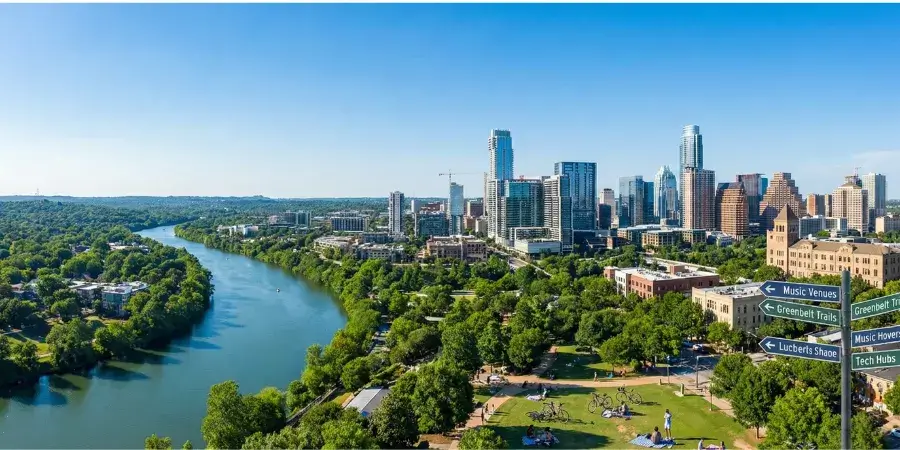If you are thinking about moving, the city you pick can make a substantial difference in how you feel day-to-day. Consider this: the city of austin texas was ranked No. 9 out of 150 places as one of the best places to live in the U.S. for 2024-2025.
Its reported median household income sits at around US$96,149. What this tells us is that austin texas is not just a trendy destination, it is a serious contender for people who want a strong mix of work opportunity, lifestyle and future potential. The real question is: will it match your priorities and what you value in a home base? Let us break it down clearly.
Why Living in Austin TX could appeal to you
- Vibrant culture and lifestyle: austin texascarries the nickname Live Music Capital of the World, you will find live music in small bars, major festivals, and even unexpected venues. The city offers a rich food scene: from food trucks to Tex-Mex to BBQ classics, there is variety and local character. Outdoor life also plays a major role. The warm Austin climate, numerous trails, lakes and parks invite a lifestyle where you can switch from work-life to nature fairly easily. What this really means is: if you value a place where after work or on the weekend you can hike, swim or see a great show, austin texas gives you those options and supports a distinct Austin lifestyle.
- Strong job market and education ecosystem: The local economy is more than just entertainment and lifestyle. The tech sector, education institutions (such as University of Texas at Austin), and a diverse set of industries make up a meaningful part of the city’s foundation. For someone looking to grow in their career, or position themselves where there is momentum, that matters. High educational attainment among residents also suggests that the city draws talent and supports growth. In practical terms: Moving to Austincould mean being in a place where opportunities exist and you will be surrounded by people who are working, learning and building within a growing Austin economy and a strengthening Austin job market.
- Reasonable Austin cost of living(relatively) and access to nature: While no major city is cheap in all regards, austin texas compares favourably to some of the larger, more expensive metro areas. For example, cost of living and Austin housing can still be more manageable than places like New York or San Francisco when you make the comparison. The fact that you can access nature, rivers, lakes, parks, without a long commute is a significant plus. In simpler terms: you might get a better trade-off for city + nature here than in many major metro areas. This also helps anyone wondering whether Is Austin a good place to move for work because the balance of opportunity and cost plays a meaningful role.
- Community, creativity and lifestyle fit: austin texashas a character that many find appealing. The city’s vibe leans friendly, creative, open-minded and centred on local culture. The motto Keep Austin Weird is more than a slogan, it represents a mindset. If you are the type of person who wants some mix of great stuff (job, culture, nature) but does not want to live in a place where life feels totally disconnected or hectic, austin texas could strike a balance. What this really means is: your non-work life, weekends, evenings, personal growth, can matter here and feel supported. Many talk about the Pros and cons of Austin, and lifestyle fit often ranks high for newcomers.
What Living in Austin TX involves in practice
- Housing and Austin cost of living: Housing tends to be the largest expense for someone Moving to Austin. Some recent data show the monthly cost for a single person runs around US 2,700 to 2,900 including rent, utilities, food and transport. Other sources suggest comfortable living for a single person may require around US 78,000 plus per year or more while for a family of four it might be US 145,000 plus per year. This aligns with general discussions about Cost of living in Austin for newcomers.
When we drill into rent, one-bedroom apartments in the city center range roughly US 1,500 to 1,800 per month, depending on the neighbourhood.
What this really means is that your budget needs to be realistic. If you are coming from a place with much lower rent, you will notice the difference. If you pick a neighbourhood farther out from downtown or in a suburb, you may save significantly.
Also utilities and other costs matter. One report says utilities for a single apartment might run US 180 to 200 monthly. So when you add rent plus utilities plus transport plus groceries you need to plan accordingly.
- Neighbourhoods and diversity: Austin neighborhoodsoffer a wide range of ways to live. There are vibrant, dense neighbourhoods downtown or near the university; there are calmer suburbs; there are rural-edge areas if you do not mind a longer commute. Because of this diversity you can tailor the living experience to your preferences.
For example if you pick a neighbourhood with good access to public transit or amenities you will reduce car-dependence. If you move out to the suburbs you will trade a longer commute for perhaps more space or a quieter street.
Because the city is growing fast, some neighbourhoods are under pressure: Austin housing prices may be climbing, development may be more active, infrastructure may shift. So your neighbourhood choice influences not only cost, but how settled you feel.
- Transportation and commuting: Getting around in austin texasis doable, but how you do it depends a lot on where you live relative to where you work and how you choose to travel. Driving remains common, especially for people living farther from the core. That means you will need to account for car payment, insurance, fuel, parking and time lost in traffic.
If you live closer in or pick a place well-served by transit, biking or walking might be more realistic. One infrastructure programme, Project Connect, is planned to expand public transit options in the greater Austin area.
What this means in practice: when you are evaluating a move, check how far your commute will be, what transit options exist, how traffic is during your likely travel times. A location that looks cheap on rent but adds 40 minute commutes each way may reduce your real living satisfaction and is something to consider under What to know before moving to Austin.
- Lifestyle, amenities and everyday reality: Living in austin texasmeans more than just a place to sleep. You will have access to outdoor recreation including parks, lakes and trails, a strong cultural scene featuring music, food and festivals, and growing business and tech opportunity. That adds value to your daily life. But you will also navigate the reality of rapid growth. More new residents means more competition for Austin housing, more development, more traffic and potential change in community character. The Austin quality of life often balances these shifts, but it helps to keep expectations grounded.
In terms of everyday cost: groceries are reported to be slightly below or close to U.S. average in some categories, though housing pushes the total cost higher. When you plan your budget, allocate variable costs such as dining out and entertainment. These are part of what makes Living in Austin TX appealing, but they need to be sustainable in your budget and shaped by awareness of the Austin cost of living.
Things to be aware (challenges)
Here are some trade-offs you should know up front:
- The city is growing fast. Infrastructure, housing stock and services may lag in some areas. That means waiting for transit improvements, adjusting to new development and sometimes dealing with growing pains that influence how you experience the Pros and cons of Austin.
- Even though austin texasmay look affordable compared with ultra expensive cities, it is above many other Texas cities and many U.S. cities for certain costs. One guide ranks Austin’s cost index higher than Dallas, Houston and San Antonio. This ties into broader conversations about the Austin economy and how it supports long term affordability.
- Summer weather in austin texascan be very hot. Cooling bills, heat in housing and the feeling of being in a warm Austin climate for months all factor into daily living comfort. That may add hidden cost including AC use and energy bills and influence your preference of house type and neighbourhood.
- If you pick a location far from your workplace or amenities, you may spend time in commute and lose convenience. That can offset many of the benefits of Living in Austin TXand is something to consider when deciding Is Austin a good place to raise a family because commute patterns affect daily ease.
- Because of growth, housing markets can be tight. While rents in some areas may be stabilising or even dropping in certain periods, Austin housingremains one of the biggest cost components. You will want to keep an eye on local trends. One study noted rental asking price declines in 2025 in austin texas.
Who lives well in Austin TX and who might find it less ideal
Thriving in austin texas
- Young professionals or early to mid career individuals. With a median age in the metro area around 34 years, austin texashas a large share of residents aged roughly 25 to 44.
- Those in tech, creative roles or who value a dynamic work and life mix. Austin’s job market, growth in tech and culture of innovation play well if you like a place where many others are Moving to Austinfor opportunity and wondering Is Austin a good place to move for work.
- People who value an active lifestyle. Outdoor amenities, music, food and a social scene shape the broader Austin lifestyle. Austin offers hiking trails, lakes, live music venues and a community that supports social and cultural engagement.
- Individuals or couples without very fixed priorities around ultra low cost housing or ultra rural quiet. If you are flexible about neighbourhood and can budget for Austin housingin a growing city, you can find a good fit.
Less ideal fits for austin texas
- Households for whom affordability of housing is the top priority and budget is tight. While austin texashas many strong features, housing prices have climbed and certain neighbourhoods can be expensive.
- People seeking a very slow pace, strong separation from growth or minimal change. austin texasis growing rapidly including metro population increases and an influx of new residents. That means infrastructure, housing markets, traffic and development are all in flux.
- Anyone craving genuinely rural living or very large properties with ultra quiet surroundings and small town feel. If your ideal is wide open space, very low population density and long drives, a city like austin texasmay feel more urban or more in transition than you prefer.
- Older retirees or families who strongly prioritise ultra short commutes or minimal transitions. Growth can bring changing traffic, development pressures and shifts in community character that matter when evaluating What to know before moving to Austin.
In short: living in austin texas means combining many positive features including culture, outdoors and job opportunity with real cost and logistic realities. If you pick the right neighbourhood, budget realistically and accept that some trade offs exist, you can make a move that feels exciting rather than overwhelming and fits well with the overall Austin lifestyle.







